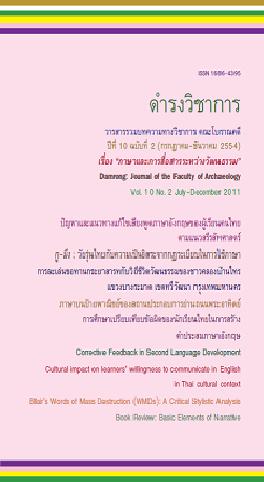A COMPARISON OF ERRORS OF THAI STUDENTS IN THE FORMATION OF ENGLISH WORDS
Keywords:
คำประสม, การสร้างคำ, ภาษาอังกฤษAbstract
This article reports an experimental study that aimed at investigating compound of Thai students with different English language experiences in the formation of English compound words equivalent to Thai compounds. The data were collected from 60 students, selected from 330 first-year university students by their English language experience levels determined by the scores acquired from a language exposure questionnaire. There were 30 students in each group that had the highest and lowest English language experiences. The sample groups were required to construct 80 English compound words equivalent to Thai compounds which are borrowed loans. Reaction time was not investigated. The test results from the 2 sample groups demonstrated that the proficiency of L2 lexical access was related to learners L2 experiences. They also exhibited a continuum of English word formation strategies. The result from the low L2 group revealed that they had limited English lexical items in their lexicon. In addition, an avoidance strategy was used frequently in the low group. It was also found that L1 transfer was salient in the English formation patterns of the low L2 group, both in the conceptual and orthographical aspect. However, in bilinguals with high L2 experience, there was a large diversity of L2 compound word formation strategies with a high level of grammatical accuracy. The high group also used a semantic network, and no avoidance strategy was used, in contrast to the low L2 learners.
References
มธุรส วิสุทธิกุล. (2531). โครงสร้างภาษาอังกฤษ พิมพ์ครั้งที่ 10 กรุงเทพฯ: สำนักพิมพ์มหาวิทยาลัยรามคำแหง
ราชบัณฑิตยสถาน. (2546). พจนานุกรม ฉบับราชบัณฑิตยสถาน พ.ศ. 2542. กรุงเทพฯ นานมีบุคส์พับลิเคชั่น.
อมรา ประสิทธิ์รัฐสินธุ์. (2525). ลักษณะของการยืมภาษา และวัฒนธรรมต่างประเทศที่ปรากฏในภาษาไทย. ศาสตร์แห่งภาษา, (2), 63-78
อมรา ประสิทธิ์รัฐสินธุ์. (2548). ภาษาในสังคมไทย ความหลากหลาย การเปลี่ยนแปลง การพัฒนา. กรุงเทพฯ: สำนักพิมพ์แห่งจุฬาลงกรณ์มหาวิทยาลัย
Briere, Eugene. John. (1968). A Psycholinguistics Study of PhonologicalInterference. Paris: C.H. Van schooneveled Indiana university, TheNetherland by Mounton and Co., The Hague.
Corder, S.P. (1973). Introducing Applied Linguistics. Middlesex: Penquin.
George, H.V. (1972). Common Errors in Language Learning. Newbury House.Rowley, Mass.
Luksaneeyanawin, S. (2007). Unfolding linguistics. In Wirote Aroonmanakun (ed.)Unfolding Linguistics. Bangkok: Chulalongkorn University Printing.
Miller, G.A. & P.N. Johnson-Laird. (1976). Language and Perception. Cambridge,Mass: Harvard University Press.
Newmark, L. (1966). How not to interfere with language learning. InternationalJournal of American Linguistics(32nd ed., Vol. 1, pp. 77-83).
Richards, J.C. (1971). A non-contrastive approach to error analysis. EnglishLanguage Teaching 25(3)
Selinker, L. (1972). Interlanguage. International Review of Applied Linguistics inLanguage Teaching x: 3.
Sudasna Na Ayudhya, Panornuang. (2002). Models of mental lexicon in bilingualswith high and low second language experience: an experimental studyof lexical access. Doctoral Dissertation, Chulalongkorn University, Bangkok.
T’sou, Benjamin K. (1975). On the linguistic Covariants of Cultural Assimilation.Anthropological Linguistics 17 (Vol. 9, pp. 445-465).
Weinreich, Uriel. (1953). Language in Contact. New York: Linguistic Circle and theHague: Mouton.
Downloads
Issue
Section
License
บทความนี้เป็นผลงานของข้าพเจ้าแต่เพียงผู้เดียว และ/หรือเป็นผลงานของข้าพเจ้าและผู้ร่วมงาน ตามชื่อที่ระบุในบทความจริง และเป็นผลงานที่มิได้ถูกนำเสนอหรือตีพิมพ์ที่ใดมาก่อน





